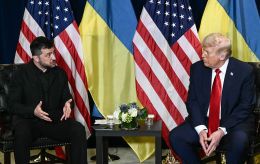Ukrainian forces' invasion of Kursk region impacts entire theater of operations - ISW
 Photo: It will not be easy for the Russians to regain the upper hand due to the Ukrainian Armed Forces' operation in the Kursk region (Getty Images)
Photo: It will not be easy for the Russians to regain the upper hand due to the Ukrainian Armed Forces' operation in the Kursk region (Getty Images)
The Ukrainian military's incursion into Russia's Kursk region has had a significant impact on the entire theater of operations and will influence both Russian offensive and defensive capabilities even after the current advance on Pokrovsk is concluded, according to the Institute for the Study of War (ISW).
According to a report citing an interview with the Commander-in-Chief of the Armed Forces of Ukraine Oleksandr Syrskyi by CNN on September 5, the Ukrainian operation in the Kursk region has disrupted a planned Russian attack on the Sumy region and reduced the threat of a Russian incursion into northern Ukraine.
Oleksandr Syrskyi stated that the primary objectives of the Ukrainian incursion were to prevent Russian forces from using the Kursk region as a base for preparing offensive operations in Ukraine, divert Russian troops from other unspecified areas of Ukraine, create a security zone, capture Russian prisoners of war, and boost Ukrainian morale.
What units Russians moved to the Kursk region
The ISW report also detailed the military units that Russia has deployed to the Kursk region. These include elements of the 56th Airborne (VDV) Regiment (7th VDV Division) and the 11th and 83rd VDV brigades.
"The Russian military command has largely relied on conscripts and regular and irregular forces redeployed from lower priority sectors of Ukraine, such as northern Kharkiv Oblast, to conduct defensive operations in Kursk Oblast," the ISW states.
ISW analysts believe that these forces are unlikely to be sufficient to dislodge Ukrainian troops from the Kursk region if the Ukrainians decide to defend the territories they have seized.
Furthermore, the report notes that in mid-August 2024, the Russian military command likely redeployed at least one company of the 15th Motorized Rifle Brigade (2nd Combined Arms Army, Central Military District) from the direction of Pokrovsk.
"The redeployment of elements of the CMD — which is reportedly tasked with completing the seizure of Pokrovsk — suggests that the Russian military command has not been able to fully insulate its priority offensive operations from the impacts of the Ukrainian incursion, despite Putin's claims," the ISW report states.
Russia's control over the initiative is under question
ISW analysts also noted that the incursion into the Kursk region allows the Ukrainian Armed Forces to challenge Russian control over the overall military initiative in Ukraine.
The report highlights that Russia has maintained the overall military initiative in Ukraine since at least November 2023. This has allowed Russian military command to dictate the location, timing, scale, and requirements of combat operations in Ukraine at its discretion, forcing Ukrainian forces to expend human and material resources on rapid defensive actions.
ISW recalled that General Syrskyi recently stated that Russia redeployed about 30,000 troops from Ukraine to the Kursk region in response to the Ukrainian incursion.
"A significant additional redeployment of Russian troops from the frontline in Ukraine would very likely be necessary to let Russia regain control of its territory in Kursk, as US intelligence officials have reportedly assessed, and would significantly impact Russia's offensive operations and Russia's ability to prepare for future operations," the ISW report states.
Situation in the Kursk region
In early August, Ukrainian forces launched an offensive operation in the Kursk region. The objectives include preventing a Russian incursion into the Sumy region and protecting residents of the Kursk region from aerial attacks.
To date, Ukrainian forces have taken control of more than 100 settlements in the Kursk region.
President Volodymyr Zelenskyy believes the Kursk operation demonstrates that Russia could lose the war with Ukraine.
General Syrskyi outlined five objectives of the Ukrainian operation in the Kursk region.
NATO Secretary General Jens Stoltenberg stated that the operation in the Kursk region has allowed Ukraine to achieve significant milestones. However, predicting further developments remains challenging.

